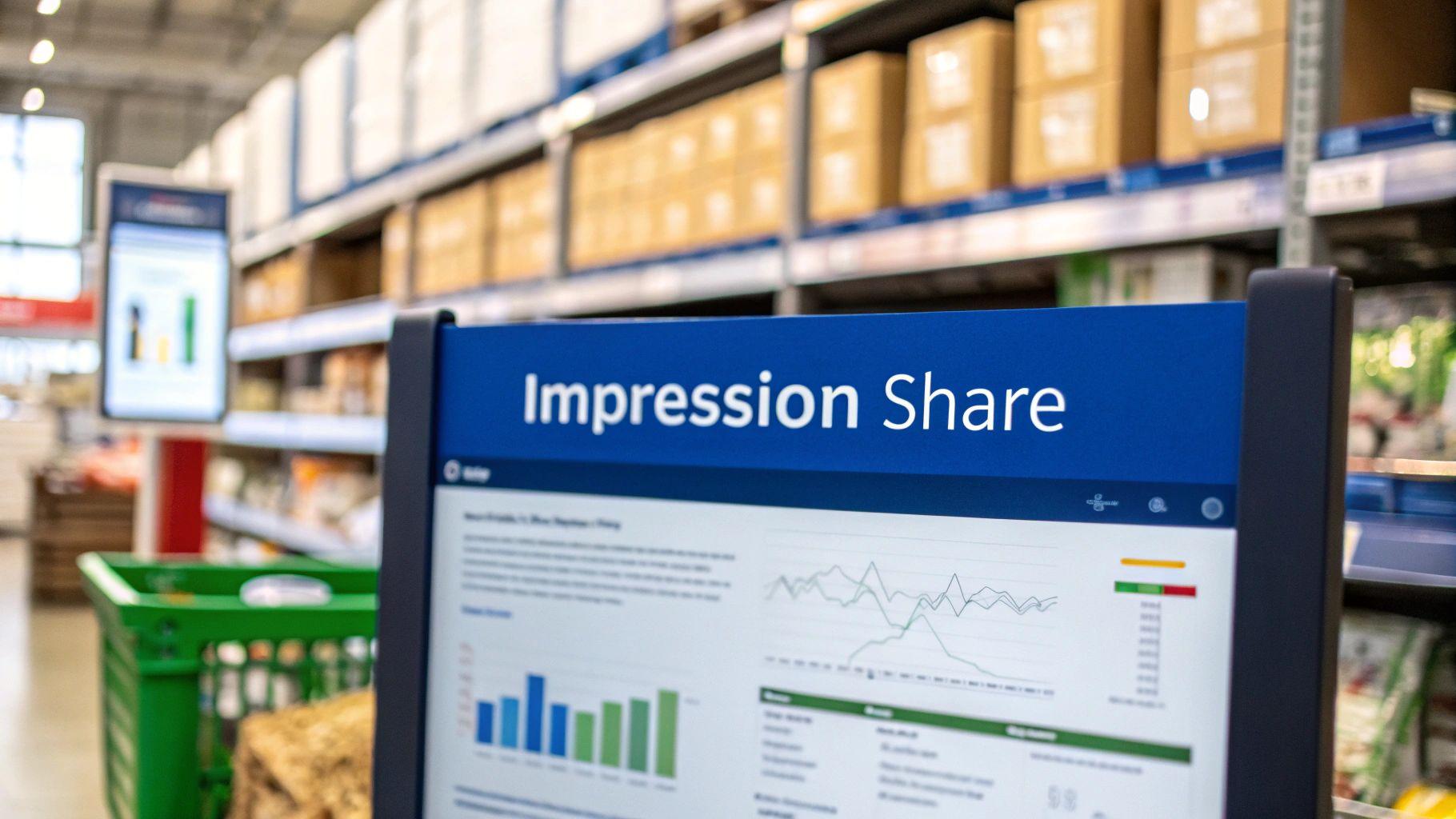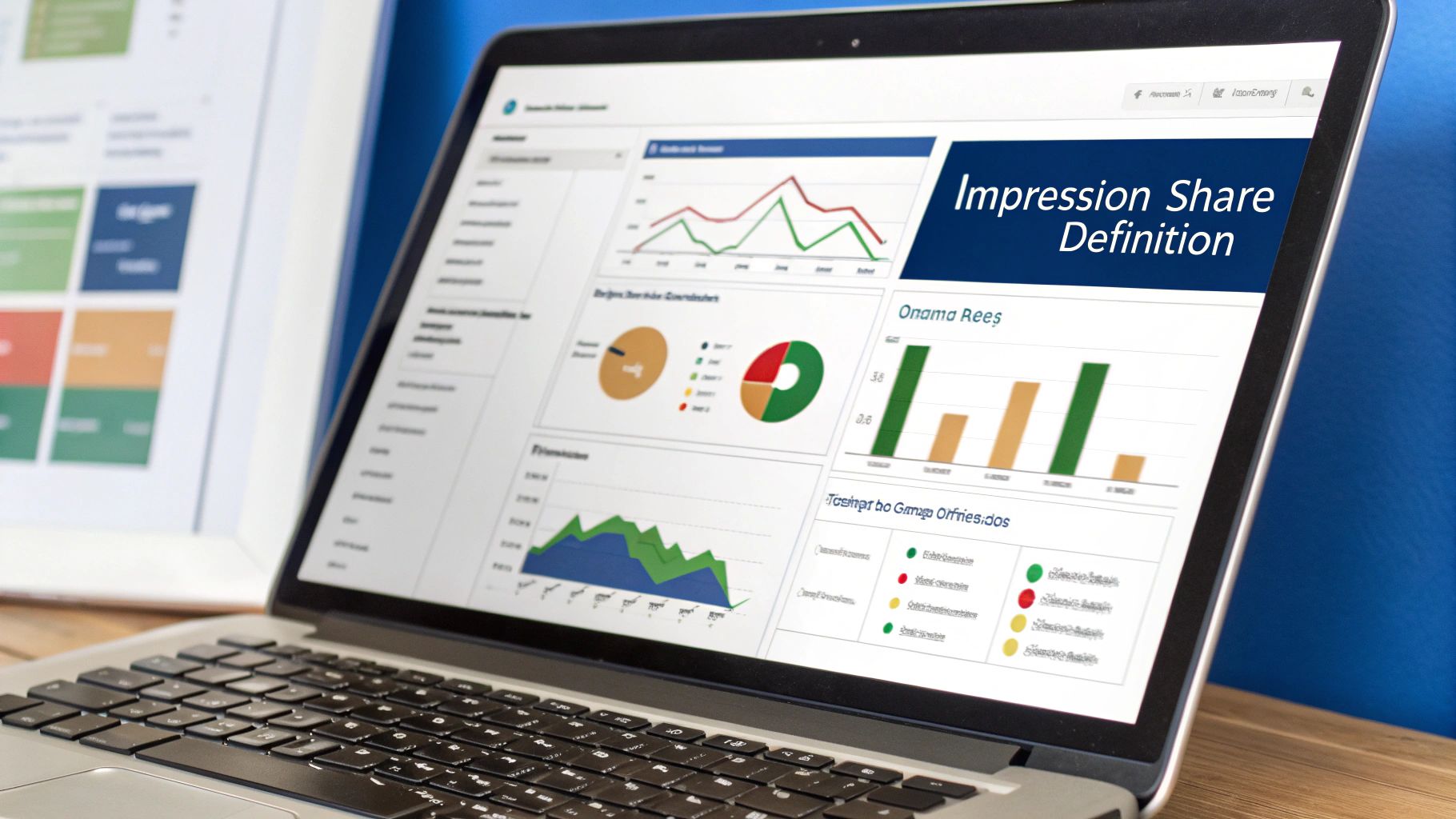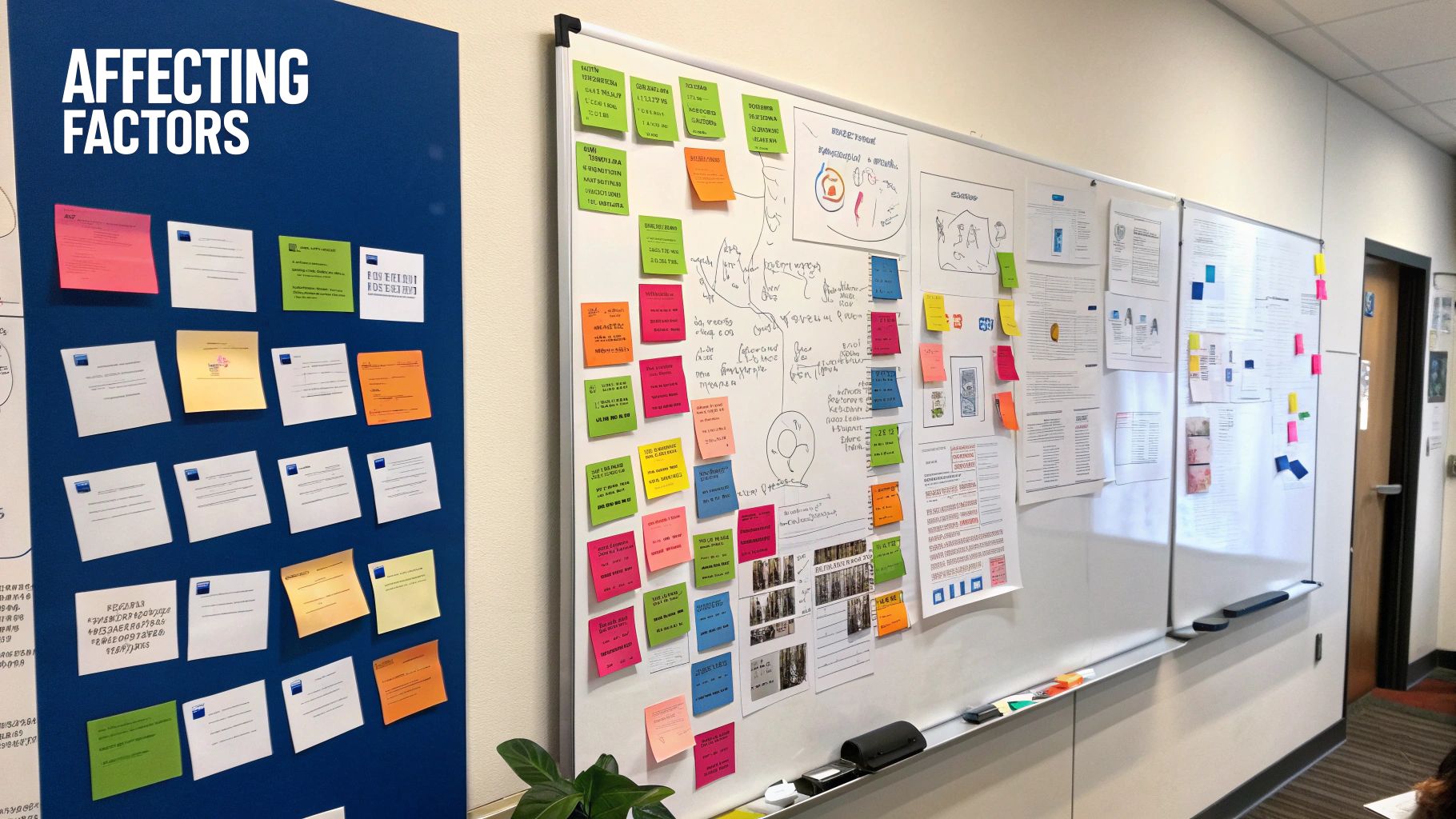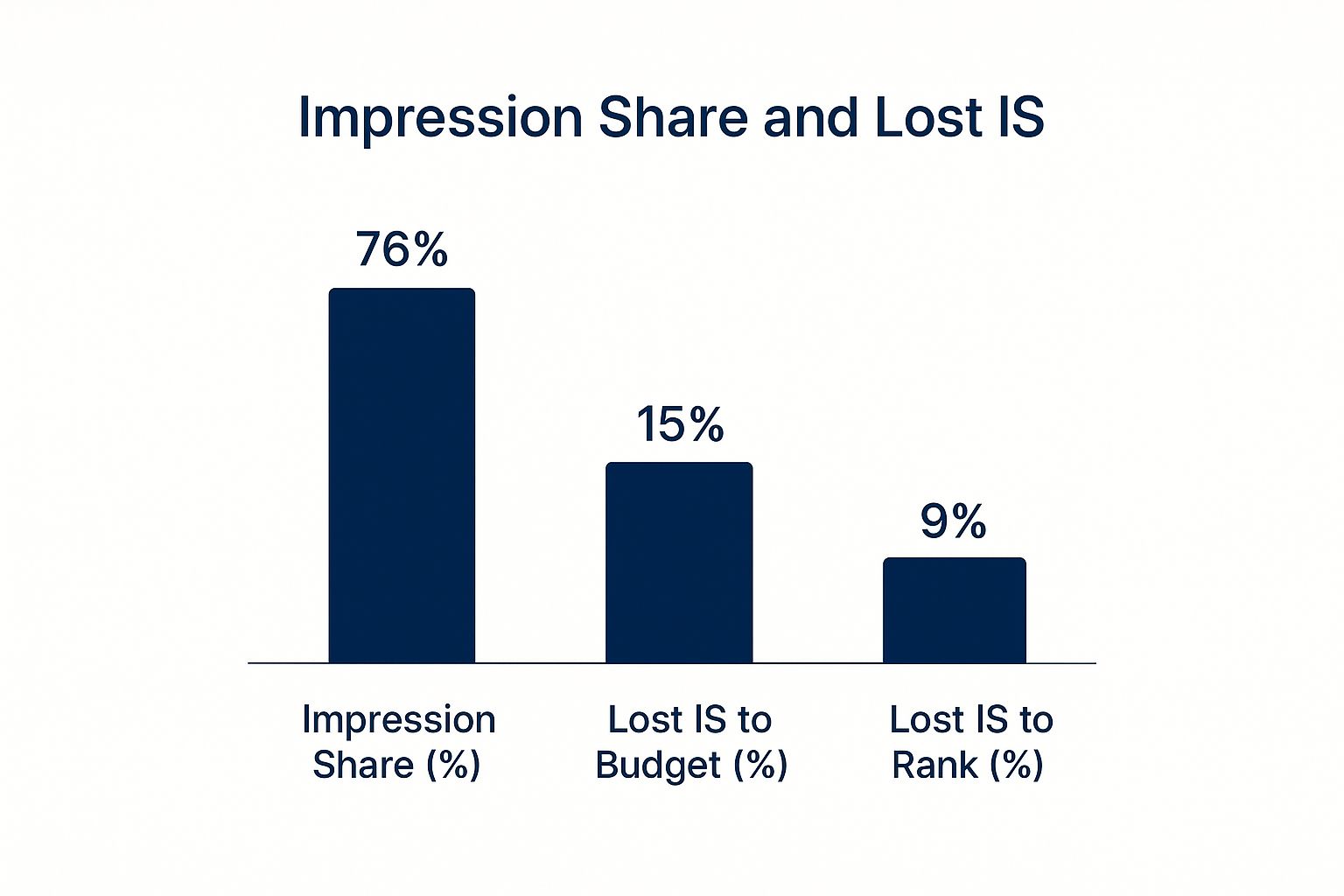What is Impression Share? A Performance-First Guide for Brands
Discover what is impression share and how understanding this metric can boost your visibility and outperform competitors. Learn more now!

Clicks and conversions tell you what you won. Impression share tells you how much of the war you're losing.
For eCommerce leaders, impression share isn't a vanity metric; it's a direct measure of your brand's presence on the digital shelf. It’s the percentage of times your ad was shown versus all the times it could have been shown for a given keyword. It's your share of voice, your slice of the market, and a leading indicator of both your current sales and future organic rank.
The Underrated Power of Impression Share

It’s easy to fixate on efficiency metrics like ACOS (Advertising Cost of Sale) or ROAS (Return on Ad Spend). They’re critical for profitability, but they only report on the auctions you won. They completely ignore the massive opportunity cost of the auctions you lost—or never even entered.
A low impression share isn't a missed ad; it's a sale you handed to a competitor. Every time your ad fails to appear for a relevant, high-intent search, you can guarantee a competitor’s ad does. This has a direct, measurable impact on your sales velocity—the single most important signal to Amazon’s A9 algorithm.
Connecting PPC to Organic Growth
This is where performance-first brands separate themselves. A high impression share, particularly on core, non-branded keywords, is one of the most powerful levers for driving sustainable organic growth.
The flywheel is simple and powerful:
- Dominate Visibility: By owning impression share, your product is perpetually in front of high-intent shoppers.
- Fuel Sales Velocity: This sustained visibility drives more clicks and, crucially, more sales through your paid campaigns.
- Boost Organic Rank: Amazon’s algorithm registers this strong sales velocity and rewards your product with higher organic search placement.
You're not just buying clicks. By strategically investing in paid visibility, you're buying data that trains the algorithm and kicks off a cycle that elevates your entire brand presence. It’s a long-term play for defensible market leadership.
Key Takeaway: Impression share is a leading indicator of market dominance. Monitoring it is essential for gauging competitive pressure and directly influencing the sales velocity that fuels your organic ranking on Amazon.
Understanding the Calculation
The formula is straightforward: impression share is the number of impressions you received divided by the total estimated number of impressions you were eligible to receive.
This simple calculation is incredibly revealing. It tells you if you're being outspent (losing impressions to budget limitations) or outmaneuvered (losing impressions due to low ad rank and weak bids). Knowing why your share is low is the key to making smarter decisions about budget allocation and campaign optimization.
For a deeper dive into this and other critical metrics, review our guide on essential online advertising performance metrics.
How to Calculate and Find Your Impression Share

Knowing the definition is one thing; leveraging the data is another. Fortunately, both the calculation and the data are easily accessible once you know where to look.
The formula is simple:
Impression Share = (Your Impressions ÷ Total Eligible Impressions) x 100
Consider a real-world scenario: For the keyword "organic dog food," Amazon estimates 10,000 eligible impressions in a day. Due to budget caps and ad rank, your campaign only secures 6,500 of them. Your impression share is 65%. That remaining 35% represents 3,500 missed opportunities where shoppers saw a competitor’s product instead of yours. This metric quantifies exactly how much of your addressable audience you're actually reaching.
Finding Your Impression Share on Amazon
This data is readily available in the Amazon Advertising console, but it isn’t shown by default. Adding it to your dashboard is a critical first step.
- Navigate to your Ad Console: Log in and go to the "Campaigns" tab.
- Customize Your Columns: Click the "Columns" button above your campaign data table and select "Customize columns."
- Add Competitive Metrics: Locate the "Competitive metrics" section. Add Search IS (Search Impression Share) and Search Top of Search IS to your view and save.
Once enabled, you can analyze impression share at the campaign, ad group, or keyword level. This granular view is what empowers you to make precise, surgical adjustments to your strategy. To get more comfortable with the full suite of data, our guide to understanding Amazon advertising reporting is an excellent resource.
The Key Types of Impression Share
Amazon provides several impression share metrics, but two are non-negotiable for understanding your brand’s visibility on the keywords that drive growth.
Search Impression Share (Search IS): This is your overall share of voice. It measures the percentage of impressions your ads received across all placements on the search results page versus the total possible impressions. A low Search IS is a clear indicator that you're leaving significant market share on the table.
Top-of-Search Impression Share (ToS IS): This is the premium real estate. This metric isolates your impression share for the ad slots at the very top of the first search results page. Winning here is a primary driver of sales velocity, as you capture the most engaged and highest-intent shoppers.
Tracking both provides a complete picture. You’ll know not just if you're visible, but where that visibility is occurring. That’s the difference between merely participating in the ad auction and strategically winning the placements that move the needle on profitability and scale.
What's a Good Impression Share, Anyway?

What number should you aim for? While it’s tempting, chasing a 100% impression share is a costly and strategically flawed goal. The objective isn't to appear for every search; it's to dominate the searches that drive profitable growth.
A smarter approach is to set dynamic benchmarks aligned with specific business goals. Your targets must adapt based on campaign objectives, product lifecycle, and competitive intensity. This prevents you from wasting budget on low-converting visibility and channels spend where it will have the greatest impact on your bottom line.
Match Your Benchmarks to Your Strategy
Applying a single impression share target across your entire account is a recipe for wasted ad spend. Not all keywords are created equal, and your strategy should reflect that.
Instead, segment your goals at the keyword level. Here’s a performance-first framework:
Brand Defense: For your branded keywords, the goal is total domination. Aim for an impression share above 90%. Anything less is an open invitation for competitors to siphon off customers actively searching for you.
Top Performers: These are your core, non-branded, high-conversion keywords. A strong, profitable target here is 70-80%. For example, a top-selling coffee brand might target 80% IS for "dark roast coffee beans" to maximize sales velocity and defend its organic rank.
Discovery & Expansion: For broader keywords, new product launches, or market research campaigns, a lower impression share is strategic. The goal here isn't to own the SERP; it’s to gather data efficiently, identify new opportunities, and validate keyword viability before scaling spend.
This table outlines how to set impression share targets based on specific campaign objectives.
Impression Share Benchmarks by Campaign Goal
| Campaign Goal | Keyword Type | Target Impression Share | Strategic Rationale |
|---|---|---|---|
| Brand Defense | Your brand name & variations | 90%+ | Protect high-intent shoppers and control the brand narrative. |
| Aggressive Growth | High-volume, converting keywords | 70-80% | Maximize visibility on core terms to fuel sales velocity and organic rank. |
| Profitability Focus | Proven, efficient keywords | 50-70% | Maintain a strong presence without overbidding, balancing growth with ACOS. |
| New Product Launch | Broad & long-tail keywords | 30-50% | Gather performance data and test keyword viability with controlled spend. |
| Market Research | Top-of-funnel, general terms | < 30% | Explore new opportunities and gauge market size with a limited budget. |
Setting tiered targets allows for far more deliberate capital allocation, ensuring every dollar works toward a specific, measurable outcome.
Looking Beyond Amazon for Context
It helps to benchmark against the broader PPC landscape. Impression share has long been a core metric on platforms like Google Ads, where a healthy search campaign often targets an IS between 60% and 90%, depending on budget, ad quality, and competition.
Reviewing industry-specific Google Ads benchmarks can provide a valuable external reference point. This context helps validate whether your targets are realistic for your category and can prevent you from under-investing or overspending relative to your peers.
The Headline Takeaway: Forget the vanity of a 100% impression share. The winning strategy is to set intelligent, tiered benchmarks that align with your business goals. Concentrate budget on owning your branded terms and dominating your most profitable keywords. That’s how you build momentum, accelerate organic rank, and achieve sustainable, profitable scale.
Finding Out Why You're Losing Impression Share
A low impression share is a diagnostic tool. It signals that revenue is leaking to competitors. Before you can reclaim that market share, you must diagnose the cause. Amazon breaks down lost visibility into two primary culprits.
Your campaign report provides the key evidence: Impression Share Lost to Budget and Impression Share Lost to Rank. Identifying which factor is undermining your visibility is the critical first step toward building a more resilient and profitable advertising presence.
The Budget Problem: Running Out of Gas
Impression Share Lost to Budget is the more straightforward issue. It means your ads were competitive enough to be shown, but your campaign’s daily budget was exhausted.
For example, a snack brand might see its "Lost IS (Budget)" for "healthy office snacks" spike to 40% after 2 PM. This indicates their budget is depleted mid-day, leaving the field open for competitors during the high-traffic afternoon and evening hours. It's a clear sign of unmet demand.
The Rank Problem: Failing the Auction
Impression Share Lost to Rank is more complex. This occurs when you have sufficient budget, but your ads still fail to appear because they aren't competitive enough to win the ad auction. Your Ad Rank—a score determined by your bid and ad relevance—is too low.
This is a common pitfall. You could have an unlimited budget, but if your bids are too low or your ad and product detail page lack relevance for the search query, Amazon will not show your ad. For instance, bidding on "vegan protein powder" when your product title is simply "Plant-Based Protein" and lacks specific vegan callouts will result in a poor relevance score and a high "Lost IS (Rank)."
The Big Picture: Don't just throw more budget at a low impression share. First, diagnose the root cause. A high 'Lost IS (Budget)' indicates a need to increase or reallocate spend. A high 'Lost IS (Rank)' signals a deeper strategic problem with your bids, keywords, or listing quality that requires optimization, not just more cash.
To solve the problem, you must quantify it. Add the "Search lost IS (budget)" and "Search lost IS (rank)" columns to your campaign manager. This provides the hard data needed to distinguish between a funding issue and a performance issue—the foundation of a smart, data-driven advertising strategy.
Actionable Strategies to Increase Your Impression Share
You’ve diagnosed why you're losing impression share. Now it’s time for targeted action to reclaim that visibility. The goal isn't simply to spend more; it's to invest more intelligently.
Forget generic advice like "just raise your budget." Sustainable growth comes from precise adjustments based on whether you're losing to budget or rank.
This infographic illustrates a common scenario, showing how total potential impressions are divided between what you captured and what you lost to each factor.

This visual immediately clarifies your primary challenge, allowing you to focus your efforts where they will yield the greatest return.
Fixing Losses From a Depleted Budget
A high "Lost IS (Budget)" is a good problem. It means your ads are effective, but your campaigns are hitting their daily spending caps prematurely.
Instead of a blanket budget increase, get more strategic:
- Pace Your Spending: Use "Budget rules" in the Amazon console to prevent your entire daily budget from being spent by mid-morning. This ensures visibility during peak evening shopping hours.
- Reallocate from Underperformers: Conduct a rigorous audit. Identify campaigns or keywords with high ACOS or poor conversion rates. Systematically cut their budgets and reinvest that capital into your top-performing campaigns that are being limited by budget.
- Leverage Dayparting: Analyze your hourly sales data. If you're a coffee brand and see sales spike between 7 AM and 11 AM, concentrate your ad spend during those high-leverage periods to maximize ROI.
Winning Back Impressions Lost to Rank
If "Lost IS (Rank)" is your primary issue, increasing your budget is like pouring water into a leaky bucket. The problem is not funding; it’s performance. Your bids or ad relevance are insufficient.
The Headline Takeaway: Increasing impression share isn't about outspending the competition; it's about outsmarting them. By diagnosing whether the problem is budget or rank, you can deploy precise, data-driven tactics that improve both visibility and profitability.
This is where true https://www.headlinema.com/blog/amazon-ppc-optimization becomes critical. You must optimize every component of your campaign to improve how both Amazon's algorithm and customers perceive your ad.
Pull these strategic levers:
- Enhance Keyword Relevance: Ensure your keywords are tightly themed within ad groups and perfectly aligned with your product and ad copy. Prune irrelevant search terms that drain budget and damage your performance scores.
- Optimize Your Product Detail Page: Your conversion rate is a massive component of Ad Rank. Strengthen your product titles, bullet points, imagery, and A+ Content. A higher conversion rate signals to Amazon that your product is a superior solution for a shopper's query.
- Refine Your Bidding Strategy: Move beyond static bids. Implement dynamic bidding strategies like "Up and down," which allows Amazon to increase your bid in real-time for auctions with a higher likelihood of conversion. This lets you compete effectively without overpaying on every click.
This table breaks down the diagnosis and solution for each type of lost impression share.
Fixing Lost Impression Share Due to Budget vs. Rank
| Factor | Lost Impression Share (Budget) | Lost Impression Share (Rank) |
|---|---|---|
| Primary Cause | Profitable campaigns exhaust their daily budget prematurely. | Bids are too low, or ad/listing relevance is poor, resulting in lost auctions. |
| Common Symptom | High impression share in the morning that drops to zero in the afternoon. | Consistently low impression share throughout the day, despite an active budget. |
| Wrong Solution | Lowering bids to "save money," which will harm rank and compound the problem. | Aggressively increasing the daily budget, which will be spent inefficiently. |
| Strategic Solution | Reallocate budget from poor performers, pace spending using budget rules, and implement dayparting. | Improve keyword-to-product relevance, optimize the product detail page for conversion, and use dynamic bidding strategies. |
Executing these strategies requires deep platform expertise. It’s a challenge common across all auction-based ad platforms, which is why many brands utilize professional Google Ads services to ensure their campaigns are optimized to capture every profitable impression.
Frequently Asked Questions About Impression Share
Even with a solid understanding, applying impression share as a strategic lever raises practical questions. Here are no-nonsense answers to the most common queries we hear from brand leaders.
Is a 100% Impression Share Always the Goal?
Absolutely not. Chasing a 100% impression share is a common but costly mistake that prioritizes vanity over profit. The strategic goal isn't to appear for every possible search; it's to appear for every search that matters.
Attempting to win every impression is like a premium CPG brand trying to secure shelf space in a dollar store—it’s expensive, inefficient, and puts you in front of the wrong audience.
The smarter play is to concentrate your budget on dominating the right impressions: your branded terms, your highest-converting non-branded keywords, and conquesting campaigns against direct competitors. That’s where visibility translates directly into profitable market share.
How Does Impression Share Impact Organic Ranking?
This is where PPC becomes a lever for enterprise value. A strategic PPC approach is a powerful catalyst for long-term organic growth. The connection is direct and proven: a high impression share on relevant keywords directly impacts your organic rank via sales velocity.
The flywheel effect is undeniable:
- You Invest in Visibility: A high impression share ensures your product is consistently placed in front of high-intent shoppers.
- You Drive Sales Velocity: This sustained visibility leads to more clicks and, critically, a higher volume of sales attributed to those keywords.
- Amazon's Algorithm Rewards You: The A9 algorithm registers this consistent sales history as a strong signal of customer preference, rewarding your product with a higher organic ranking for those terms.
When you strategically invest in paid impression share, you're not just buying ads. You are feeding Amazon's algorithm the sales data it needs to recognize your product as a category leader, driving a long-term, defensible organic advantage. This is not just an advertising tactic; it's a core growth strategy.
How Often Should I Check My Impression Share?
The right monitoring cadence depends on your campaign's maturity and objective. There is no one-size-fits-all answer.
Use this simple framework:
- New Launches or Aggressive Growth Campaigns: Monitor daily. In these critical phases, you need to make rapid adjustments to bids and budgets to ensure you are gaining traction and capturing initial market share.
- Mature, Optimized Campaigns: A weekly check-in is sufficient. Here, you are monitoring for trends. A gradual decline in IS could signal a new competitor entering the market or budget constraints becoming a factor. Weekly analysis allows you to address these threats before they become significant problems.
Treat impression share as a vital sign for your brand’s health on Amazon. Regular, disciplined monitoring enables you to defend your market position, identify growth opportunities, and ensure every dollar you invest is building both immediate sales and enduring brand equity.
At Headline Marketing Agency, we don't just report on impression share; we leverage it as a strategic weapon. Our performance-first approach helps brands dominate their categories by transforming paid visibility into a powerful engine for profitable sales and sustainable organic growth. Discover how we can build a data-driven Amazon strategy for your brand at https://headlinema.com.
Ready to Transform Your Amazon PPC Performance?
Get a comprehensive audit of your Amazon PPC campaigns and discover untapped growth opportunities.